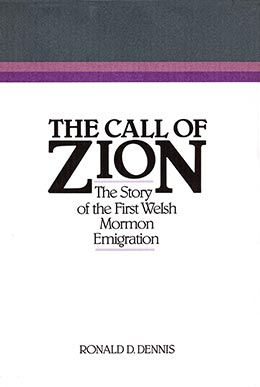Preface
Ronald D. Dennis, preface to The Call of Zion: The Story of the First Welsh Mormon Emigration (Provo, UT: Religious Studies Center, Brigham Young University, 1987), xi–xii.
Monday, 26 February 1849, was a day of great significance in the history of Welsh Mormons. On that day 249 of them set sail in the Buena Vista from Waterloo Dock in Liverpool, homeward to their “Zion.” Actually, seventy-seven other Welsh converts to Mormonism had paid their passage to travel on the Buena Vista; these, however, had to wait until one week later to leave Britain when they left on board the Hartley, a ship which contained 161 English and Scottish converts as well.
Although a few Welsh Mormons had gone to America on an individual basis after the introduction of the missionary effort into Wales in 1840, those who sailed on the Buena Vista and the Hartley constituted the first collective emigration from among the Welsh converts.
The fondest wish of these “first fruits” was that their three thousand brothers and sisters in the faith who remained in Wales would soon join them in the Salt Lake Valley, where they would live in peace and harmony far from the animosity and persecution which they had received from their nonbelieving compatriots. They desperately wanted their sea voyage and their land trek to be perfect in every way so that their success would offer encouragement to the others to follow after them. Thus the letters sent back to Wales by Church leaders were without exception enthusiastic and optimistic, almost to the point of being suspect. Captain Dan Jones, author of most of the letters concerning the migration, made even the funeral held at sea sound attractive. Hardships were minimized and conflicts were brushed aside while the primary focus was placed on the positive, adventurous, and spiritual aspects of the journey.
Jones’s letters, together with those of Thomas Jeremy and William Morgan, offer extensive documentation of the crossing of the Buena Vista and the Hartley, among the best of any crossing of Mormon emigrants from Great Britain; but these letters have been almost totally ignored by Mormon historians. Because the writers penned them in Welsh, the letters and other extensive writings were rendered mute to all but the Welsh-speaking historian, a rare breed in this country.
What began for me as a casual interest in my own Welsh Mormon ancestors eventually developed into a fascination for the history of the Welsh Mormons in general. Overcoming the language obstacle was a far greater task than I had originally thought, but the reward of being able to inject life into the once meaningless pages amply justified the effort.
My objective in this book is to present a detailed account of these “sons of Gomer,” inhabitants of the hills of Cambria, from the time they made the decision to seek rest in Zion’s chambers until they marched proudly into the Salt Lake Valley.
Appendix A contains an alphabetized list of all 326 Welsh emigrants on board the Buena Vista and the Hartley.
Appendixes B and C combine passenger list information about the emigrants with information gleaned from numerous other sources.
Appendix D is a series of biographical sketches of many of the emigrants.
Appendix E contains English translations of the complete texts of thirty items originally written in Welsh—twenty-three letters, four poems, and three periodical articles—all dealing directly with the 1849 crossing. A separate table of contents for Appendix E lists the reference number under which the entire text may be found, indicated following the quotation by TD (for Translated Documents). “TD7,” for example, would mean that item 7 of Appendix E is the full text of Dan Jones’s 28 April 1849 letter to John Davis. Other quotations from Welsh to English from documents for which the entire text is not provided are indicated by the abbreviation trans. All translations are mine.
I would like to thank D. L. Davies, Cwmaman, Wales, for offering valuable suggestions. I also wish to express appreciation to Linda Hunter Adams of the College of Humanities Publications Center at BYU for her help and editorial skills.
